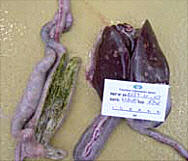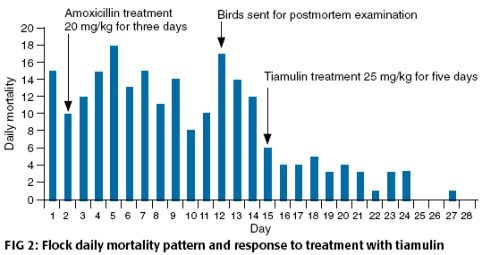



Treatment of Histomonosis in Turkeys with Tiamulin
By David Burch¹, Stuart Young² and Eamon Watson³. Since the withdrawal of products such as the nitroimidazoles (dimetridazole), there has been no medication available in the UK to treat histomonosis (blackhead) in turkeys, caused by Histomonas meleagridis.As a result, there has been a major therapeutic gap, which has caused severe health and welfare problems in affected flocks, on occasions resulting in their slaughter.
However, a case has been successfully treated with the pleuromutilin antibiotic tiamulin. In this case, the farm had six sheds of turkeys holding between 600 to 1200 birds.
We would like to inform colleagues of a case that was successfully treated with the pleuromutilin antibiotic tiamulin (Denagard; Novartis Animal Health).
In this case, the farm had six sheds of turkeys holding between 600 to 1200 birds.
The shed where the affected birds were housed, somewhat surprisingly, was concrete-floored and straw-bedded, as birds are more likely to come into contact with infected Heterakis gallinarum eggs or earthworms on soil.
At about 13 weeks of age, the birds appeared hunched, depressed and the mortality had started to increase.
Amoxicillin (Amoxinsol; Vétoquinol) was originally given for three days at 20 mg/kg bodyweight, but as there was no reduction in mortality birds were sent to the Veterinary Laboratories Agency (VLA) – Winchester, for postmortem examination.
This confirmed the presence of lesions typical of histomonosis: multiple pale circular lesions on the liver and grossly dilated caecae with necrotic caseous debris in the lumen (Fig 1).
 |
| Fig 1: Inflamed caecum with caseous necrotic material and typical circular liver lesions. |
Likely histomonad organisms were identified on caecal wet smears.
The veterinarian had previously used tiamulin to treat a commercial free-range layer flock with suspected histomonosis with moderate success.
After advice, he treated the turkeys with tiamulin via the drinking water for five days at 25 mg/kg bodyweight.
The mortality fell rapidly (Fig 2), from approximately 12 to 13 birds/day to three to four birds/day and subsequently back to normal.
Tiamulin is primarily an antibacterial and antimycoplasmal antibiotic and is not normally associated with the treatment of protozoal disease.
However, an inhibitory effect against Eimeria tenella and Eimeria acervulina in chickens has been reported (Cruthers and others 1980), when given in the drinking water at 0·025 per cent for seven days (two days before and five days after receiving a mixed challenge infection).

Tiamulin is known to be effective for the treatment of caecal infections caused by Brachyspira pilosicoli in layers (Burch and others 2006) and also to concentrate in the liver of turkeys at very high levels (EMEA 2000), where it is primarily metabolised.
In the absence of any approved medicine for the treatment of histomonosis in turkeys, tiamulin might possibly offer a therapy for use under the current cascade guidelines.
References
Burch , D. G. S., Harding , C., Alvare z, R. & Valks , M. (2006) Treatment of a field case of avian intestinal spirochaetosis caused by Brachyspira pilosicoli with tiamulin. Avian Pathology 35, 211-216.
Cruthers , L. R., Hatchkin , H. D., Sarra , L. J., Perr y, D. D. & Linkenheimer , W. H. (1980) Efficacy of tiamulin against an experimental infection of broilers with Eimeria acervulina and Eimeria tenella. Avian Diseases 24, 241-246.
EMEA (2000) Committee for Veterinary Medicinal Products. Tiamulin – Summary Report (3). EMEA/MRL/747/00-Final , July 2000. www.emea. europa.eu/pdfs/vet/mrls/074700en.pdf. Accessed December 11, 2007
Note
¹David Burch, The Round House, The Friary, Old Windsor, Berkshire SL4 2NR
²Stuart Young, Fordmore Farm, Plymtree, Cullompton, Devon EX15 2LD
³Eamon Watson, VLA – Winchester, Itchen Abbas, Winchester SO21 1BX








